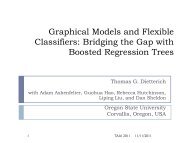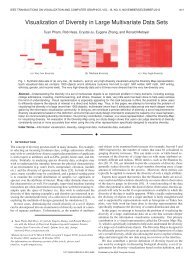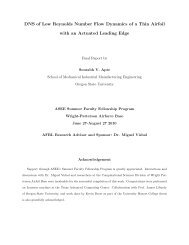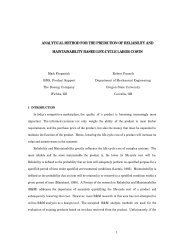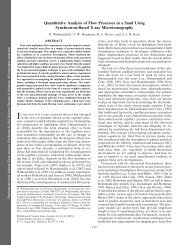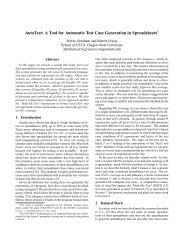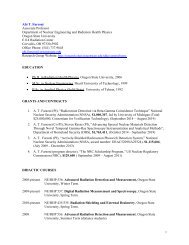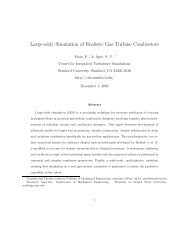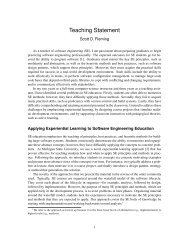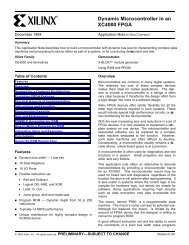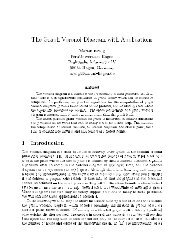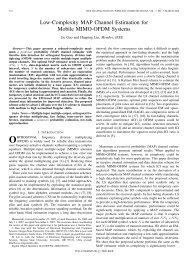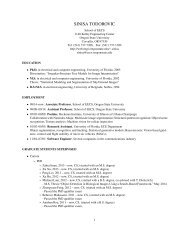ILASS Americas 20th Annual Conference on Liquid Atomization and ...
ILASS Americas 20th Annual Conference on Liquid Atomization and ...
ILASS Americas 20th Annual Conference on Liquid Atomization and ...
You also want an ePaper? Increase the reach of your titles
YUMPU automatically turns print PDFs into web optimized ePapers that Google loves.
for changes in the density of mixture. This can be<br />
the result of particle accumulati<strong>on</strong>/scattering in the<br />
flow field due to inter-phase momentum exchanges,<br />
or size variati<strong>on</strong> in a cavitating bubble due to hydrodynamic<br />
pressure of the flow, etc. Here we set up<br />
a very simple case of imposed oscillati<strong>on</strong> <strong>on</strong> the radius<br />
of a bubble which causes a potential flow filed<br />
around itself. This phenomen<strong>on</strong> can not be simulated<br />
by <strong>on</strong>ly inter-phase momentum coupling <strong>and</strong><br />
here we show that <strong>on</strong>ly through the variati<strong>on</strong>s in<br />
density in momentum <strong>and</strong> c<strong>on</strong>tinuity equati<strong>on</strong>, the<br />
potential flow is expressed.<br />
We put a single air bubble in a cube of water <strong>and</strong><br />
impose sinusoidal perturbati<strong>on</strong> <strong>on</strong> the bubble radius.<br />
Bubble radius changes in time as R = R 0 +e sin(ωt),<br />
where R <strong>and</strong> R 0 are the instantaneous <strong>and</strong> the initial<br />
radius, respectively, e is the perturbati<strong>on</strong> magnitude,<br />
ω is frequency <strong>and</strong> t is time. In this simulati<strong>on</strong>,<br />
R 0 = 0.01 × D, where D is the cube size, <strong>and</strong><br />
gives overall c<strong>on</strong>centrati<strong>on</strong> of 4×10 −6 , e = 0.1×R 0 ,<br />
ω = 50[Hz]. Figure 2 shows the radial distributi<strong>on</strong><br />
of hydrodynamic pressure around the bubble created<br />
by the size variati<strong>on</strong> at t ∗ = 0.3 where t ∗ = t/T <strong>and</strong><br />
T = 2π/ω. We compare the pressure with analytical<br />
0.008<br />
0.006<br />
Y<br />
0.004<br />
0.002<br />
0<br />
0 0.002 0.004 0.006 0.008 0.01<br />
Figure 3: Velocity vectors around the bubble caused<br />
by radius variati<strong>on</strong>s<br />
both located D/6 away from the box center. The<br />
result is a doublet-like flow which is shown in figure<br />
4. Again in this case we did not observe any<br />
1<br />
X<br />
0.8<br />
0.6<br />
1<br />
Y<br />
0.4<br />
Pressure<br />
0.99995<br />
0.9999<br />
0.2<br />
0<br />
0 0.2 0.4 0.6 0.8 1<br />
X<br />
0.99985<br />
0.9998<br />
-0.003 0 0.003<br />
r [m]<br />
Figure 4: Doublet generated by bubbles oscillating<br />
in t<strong>and</strong>em<br />
Figure 2: Pressure distributi<strong>on</strong> caused by volume<br />
displacement around the bubble, from two-way coupling<br />
(dashed line), volumetric coupling (solid line),<br />
<strong>and</strong> analytical soluti<strong>on</strong> (dots).<br />
soluti<strong>on</strong> (dots), given by [26] <strong>and</strong> result with twoway<br />
coupling <strong>and</strong> no volumetric effect (dashed line).<br />
The two-way coupling did not show any effect <strong>on</strong> the<br />
pressure, however the volumetric coupling result is<br />
in good agreement with the analytical soluti<strong>on</strong>.<br />
In another similar example we c<strong>on</strong>sider two bubbles<br />
oscillating in t<strong>and</strong>em. Two similar bubbles are<br />
put in a box <strong>and</strong> their radius changes sinusoidally<br />
with π [rad] phase shift. All properties are similar<br />
to the case of single bubble case, except they are<br />
effect <strong>on</strong> the flow in two-way coupling results.<br />
Gravitati<strong>on</strong>al Settling<br />
We simulate sedimentati<strong>on</strong> of solid particles under<br />
gravity in a rectangular box. Details of this case<br />
are given in Table 1. The initial parcel positi<strong>on</strong>s<br />
are generated r<strong>and</strong>omly over the entire length of the<br />
box. A parcel c<strong>on</strong>sists of a group of particles of<br />
equal diameter which move together. These parcels<br />
are then allowed to settle through the gas-medium<br />
under gravity. The dominant forces <strong>on</strong> the particles<br />
include gravity <strong>and</strong> inter-particle/particle-wall collisi<strong>on</strong>.<br />
As the particles hit the bottom wall of the<br />
box, they bounce back <strong>and</strong> stop the incoming layer<br />
of particles, <strong>and</strong> finally settle to a close pack limit<br />
(∼ 0.6). Figures 5(a-c) show the time evoluti<strong>on</strong> of



